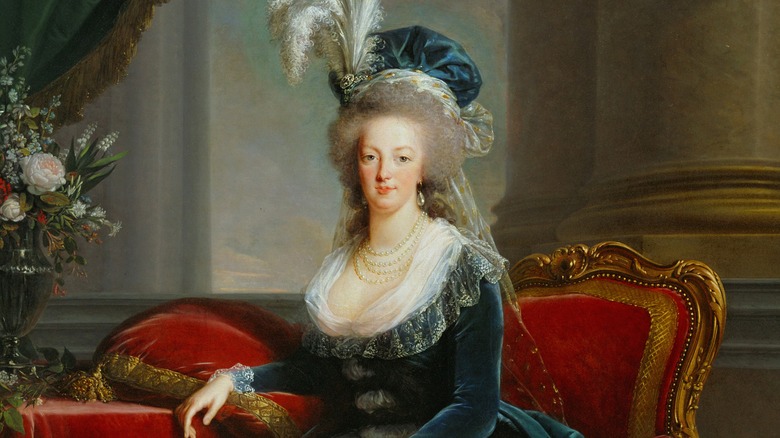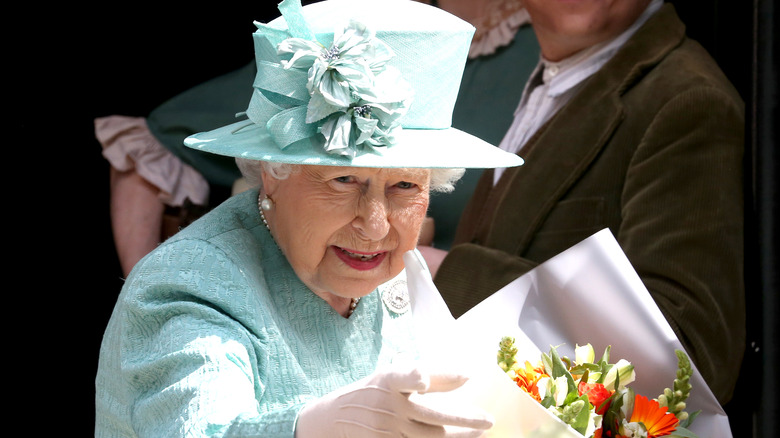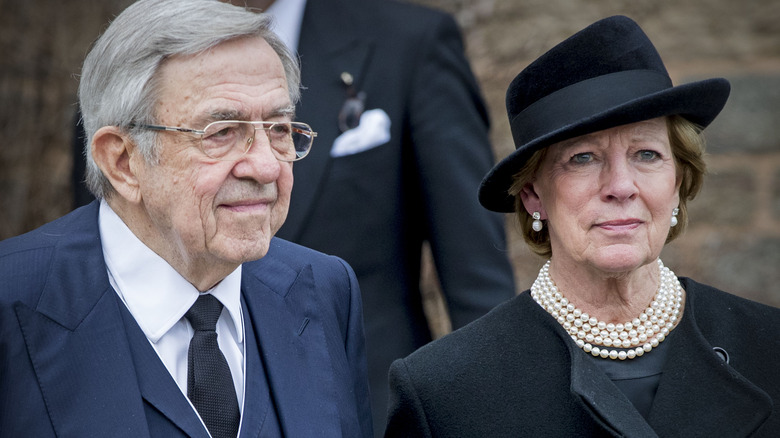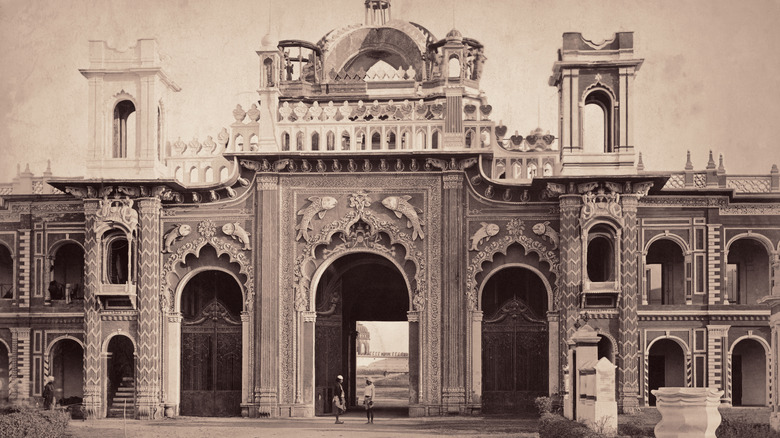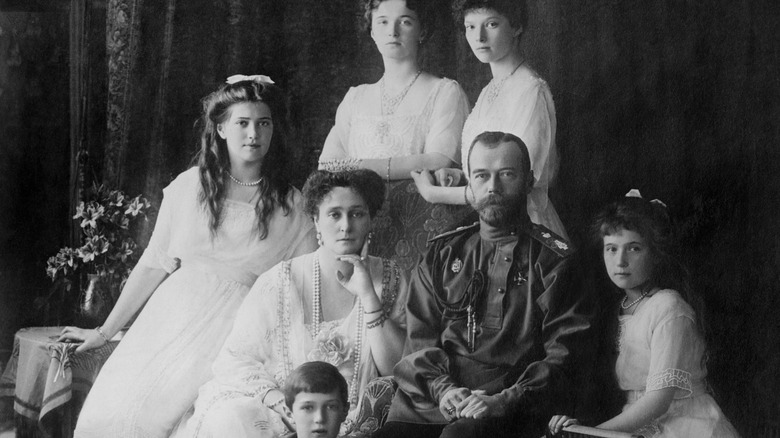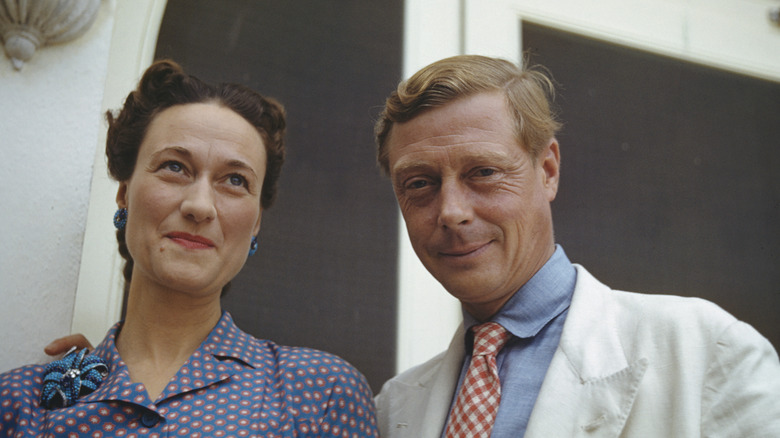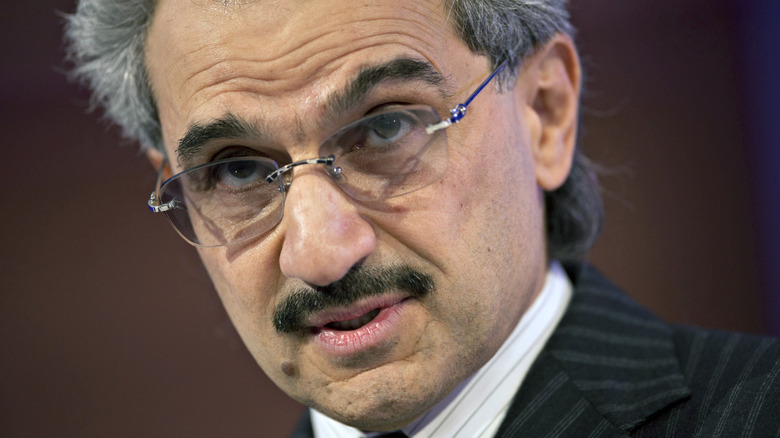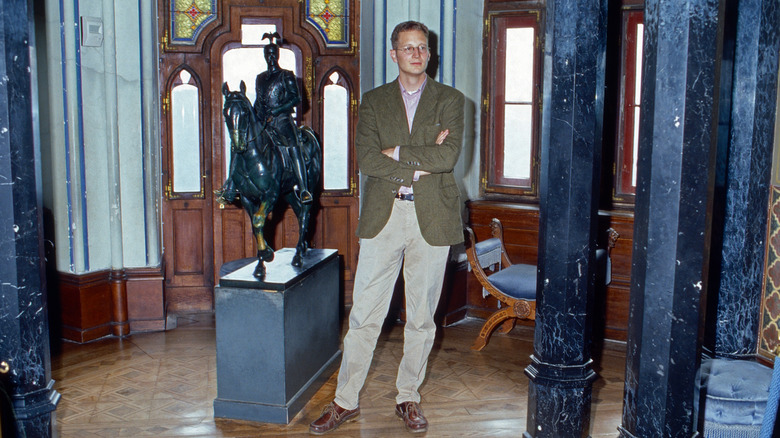Royals Who Lost Their Fortune
If you've paid attention to any kind of royal family news, especially that of the controversial variety, you've probably gathered that being a royal isn't always quite like "The Princess Diaries." And if you paid attention in world history class, you may remember learning about some royals who met with really (like really, really) bad ends. Sometimes there's a bloody revolution and the monarchy is overthrown (we're looking at you, France), and sometimes a ruler will simply step down from their royal duties. Then there are the royal family members who lose their fortunes the old-fashioned way.
Because it's important to keep history in perspective, we've rounded up some of the most notable royals who have gone from the top of the world to losing it all — or at least a significant amount of their wealth. It's a pretty long list if we're being honest, so we couldn't realistically include every deposed king or fallen princess in history. Now that we've gotten that out of the way, let's take a peek into the history of royal personal bankruptcy, shall we?
Marie Antoinette
We would be totally remiss if we didn't acknowledge possibly the most famous queen to lose her fortune in history. But of course, Marie Antoinette lost a lot more than access to the royal treasury.
It's possible that Antoinette is one of the most unfairly misremembered figures from her era. It's far from settled historical fact that she ever even said the phrase, "Let them eat cake," per Britannica, or that she was personally responsible for the country's economic disaster thanks to her large shopping budget. Nevertheless, she became a symbol of the wealthy elite's disregard for the lives of the poor during the French Revolution, and that perception of the royal still endures today.
And in fairness, Antoinette was an incredibly lavish spender. According to a signed notebook from 1781 that was put up for sale by Christie's Auction House, the queen's proposed household budget was over $915,000 — roughly $18.5 million in today's dollars. The young queen, who became known as "Madame Defécit," was fond of dressing extravagantly in diamonds and silk. According to The New Yorker, she sometimes exceeded her clothing budget of what would be $3.6 million today by as much as double.
The French Revolution was famously bloody, and revolutionaries executed hundreds of aristocrats. They eventually captured Antoinette and her husband, King Louis XVI. The couple was imprisoned and executed by guillotine, per History.com, and their young son, Louis-Charles, later died in prison. So there's really no happy ending to speak of here.
Prince Harry
Okay, it's not like Prince Harry lost his entire fortune when he and Meghan Markle decided to step down from their official royal duties — they're clearly still living pretty well out there in California. But in the couple's famous interview with Oprah Winfrey, Harry did say that leaving the royal family also meant he was cut off from their fortune, per Harper's Bazaar.
Meghan and Harry also severed their ties to the queen's "Sovereign Grant," which is the fund that pays for travel, maintenance, security, and other expenses associated with the royal lifestyle, per Forbes. The $3.2 million in renovations the couple made to Frogmore Cottage was originally paid for out of the Sovereign Grant, which is taxpayer-funded. Meghan and Harry paid back the cost of the renovations themselves after stepping down as senior royals, per BBC News. Living in their new mansion in Los Angeles is also a big bank account drain — the Daily Mail estimates their yearly expenses to be around $4.4 million.
But it's not like they're exactly paupers. Harry mentioned in the Oprah interview that he still had his inheritance from his late mother, Princess Diana, per Marie Claire. This amounts to a total sum of $10 million, according to Forbes. Not to mention that the pair has been busy signing deals with the likes of Netflix and Spotify while embarking on several other business pursuits. Plus, Meghan still has the money she earned while she was working as an actor before marrying Harry.
The British royal family
Prince Harry isn't the only member of the British royal family who has suffered a financial blow.
In September 2020, CNBC reported that the British royal family was looking at a loss of almost $45 million thanks to the COVID-19 pandemic. So, did this mean the British royals had to start downsizing? Not exactly. Planned renovations of Buckingham Palace were scaled back, while it seemed that the royals' purses would remain mostly intact — for the time being. "In responding to these challenges, we have no intention of asking for extra funding but will look to manage the impact through our own efforts and efficiencies," said Michael Stevens, the keeper of the privy purse (he's the guy in charge of managing the royals' vast wealth).
During the pandemic, the cost of living like a queen, prince, duchess, etc. was also on the rise. According to WalesOnline, the royals' costs reached $118 million for 2020-2021, a $24 million increase from the previous year. But these costs are really passed on to taxpayers, who reportedly paid $1.66 per person to keep supporting the royal family in 2020. It probably won't make them feel better to know that Queen Elizabeth II's net worth increased by almost over $20 million from 20202 to 2021, per the Sunday Times Rich List, leaving her with a net worth of around $492 million.
Princess Mako of Japan
It's not always a tragedy when a royal loses their fortune. For a rare few, including Japan's former princess Mako Komuro, it can happen on one of the happiest days of their lives. According to BBC News, Japanese law states that if a female member of the imperial family marries a commoner, she has to relinquish her royal status (for some reason, this rule doesn't apply to royal dudes). So when Princess Mako finally married her longtime commoner boyfriend, Kei Komuro, she had to give up princess-hood for good — which she seems fine with, to be honest. "I am very sorry for the inconvenience caused and I am grateful for those ... who have continued to support me," Mako said during a press conference, according to NHK (via BBC News). "For me, Kei is irreplaceable — marriage was a necessary choice for us."
She even rejected the payout that Japanese royals are given when they formally leave the family, which is a real queen-level move. The payment, a cool $1.23 million, per The Guardian, would have been funded by taxpayers, which is part of the reason Mako turned it down. She and her new husband also paid for a press conference venue themselves and got married at a registry office. Per The Cut, the couple later moved into a condo in New York, where Kei works as a law clerk. It has "a golf simulator," so they seem to be doing just fine.
Someone make this into a movie, STAT.
King Constantine II of Greece
If you're looking for a modern riches-to-rags story with some pretty swanky rags, look no further than King Constantine II of Greece. In 1964, Constantine was a handsome, 24-year-old king who had just gotten married to a beautiful Danish princess named Anne-Marie, per Town and Country. But just three years later, all hell broke loose. There was a coup, and the royal family was forced into exile. Constantine and the rest of the Greek royals were stripped of their "palaces, titles, property, and passports." After a failed countercoup, Constantine even had to ask a valet for money to fuel their escape plane. The property that he and his family lost was later valued somewhere between $500 million and $550 million.
But Constantine lived it up in England for the next several decades, even holding balls attended by other royals. Per Tatler, his home in Hampstead had 13 bedrooms and sold for over $13 million in 2013, so exile certainly didn't leave him a pauper. He put the mansion up for sale because he had decided to move back to Greece and live life as a (gasp!) commoner. When Town and Country asked the ex-king why he wanted to go back, he explained, "Look at ancient Greek history. All Greeks who live in exile, they want to go back. It's in the blood. Funnily enough, the one pushing hardest was my wife. I think she realized I would be happy only when I came back home." Sounds fair to us!
Princess Delphine Saxe-Coburg of Belgium
If there's one fairytale trope we assumed only happened in fairytales (and movie adaptations starring Anne Hathaway), it's the long-lost princess. Enter Belgium's Delphine of Saxe-Coburg, an artist who claimed for years that she was the daughter of King Albert II (who abdicated the throne), even though Albert insisted she was not. To paraphrase Lizzo, Delphine "took a DNA test, turns out [she's] 100 percent that' — by which we mean Belgian royalty.
After the DNA test proved that Delphine was Albert's daughter, she was formally granted the title of princess in 2020, according to Reuters (via CNN). But, much like her spiritual forebear Princess Mia Thermopolis, she didn't let it go to her head. "I'm still going to be Delphine, I'm not going to be hanging out in the streets and say please call me princess," she said. A lawyer representing Delphine told The Brussels Times that there would be "no question of a possible royal endowment" because she had no plans to take on any royal duties. While she missed out on access to her father's royal fortune for decades, she is "entitled to receive an inheritance," according to De Standaard (via BBC News), and Albert was ordered to pay back the $4.1 million in legal fees Delphine accrued while trying to prove her lineage.
Unfortunately, unlike the fictional Princess Mia, Delphine's royal relatives have been less than supportive. She did eventually meet with her father, according to The New York Times, so it looks like they're trying to mend fences.
Several Indian royal families
We now know India as a single unified country, but before it gained independence, it was divided into several smaller kingdoms. With these kingdoms now basically dissolved, Indian royal families have seen their wealth and power wither away. There are the descendants of Tipu Sultan, the ruler of Mysore who died during a battle with the British in 1799. According to India Today, around 100 of his descendants live in Kolkata, where they labor hard to get by. One man with royal lineage revealed that he was a rickshaw driver, while another sold kerosene. "I have ruined my health running after government officials and fighting cases in courts to realize adequate compensation for our legitimate dues," said the latter.
According to the Daily Mail, Sultana Beguma, a great granddaughter-in-law of India's final Mughal emperor, Bahadur Shah Zafar II, was living in a Kolkata slum in 2013. After her husband died, the mother of six struggled to survive on an $80-a-month pension and what little she could make sewing women's clothing. "We have been living, but God knows how," she said.
There's also the tragic tale of Brajraj Kshatriya Birbar Chamupati Singh Mahapatra of Tigiria, who went from living in a grand palace to residing in a mud hut during his final days. Per The Express Tribune, he once owned over two dozen cars and had even more servants at his disposal. His fortunes changed after India gained independence, and the country's "last prince" was relying on charity to survive when he died in 2015.
The Romanovs
Another classic fallen royals story is, of course, the tragic fate of the Romanovs, the former czars of Russia. You've likely heard the legends and conspiracy theories about Princess Anastasia (or watched the animated fairytale movie based on them).
According to The New York Times, the Romanov family, the last imperial dynasty in Russia, was worth an eye-popping $45 billion when they were taken down by the Bolshevik Revolution in 1917. This was obviously a pretty unfair situation to the rest of the country, but the way the Romanovs were taken down was almost unimaginably brutal. The family — including Czar Nicholas II, his wife Alexandra, their five children — were kidnapped and held prisoner by Bolshevik revolutionaries in Siberia, per History.com. They were all later executed by firing squad and bayonet in the basement of the house.
Though rumors that one or more members of the family managed to escape the execution have continued even today, DNA analysis of their remains proves that everyone in the immediate family was killed that day, per The Washington Post. But there is another mystery surrounding the family: A portion of their vast trove of jewelry and other treasures remains missing. According to Town and Country, they include "a sapphire tiara, a sapphire bracelet, and emerald necklace." Other items seized were documented, and some of them were listed in the book "The Last Act of a Tragedy." Per Alexander Palace Time Machine, they include gold chains and trinkets, silver serving dishes, and a large collection of fine furs.
King Edward VIII of the United Kingdom
Fans of Netflix's "The Crown" may be familiar with one of the royal family's most scandalous members, King Edward VIII, who abdicated the throne and gave up the life of luxury that came with it in 1936 in order to be with his divorced American girlfriend, Wallis Simpson. As a consequence of stepping down, Edward lost "His Royal Highness" status and was given the lower title of Duke of Windsor, according to Vogue. He and Simpson moved to France and were basically exiled from the United Kingdom because a) Edward would need permission from his brother, the new king, to return and b) coming back risked the possibility of civil unrest.
Edward spent most of the rest of his days unemployed and living in a rented house in France, Vogue reported, even though he deeply desired a government job in England. His return to his homeland was further stymied when he decided to flirt with Nazism, which, for obvious reasons, was highly frowned upon.
It turns out that money was one of Edward's primary concerns when he abdicated the throne, per The Guardian. In order to receive a greater payout from his brother, it looks like he vastly undervalued his assets, saying they were worth around $121,000 when his fortune was actually more than $1.4 million. His ruse helped him score annual payments of what amounts to $1 million today, per Forbes, and he got paid the modern equivalent of $10 million for his tell-all memoir.
Prince Alwaleed of Saudi Arabia
Not every royal or royal family is automatically worth billions of dollars — unless you're a royal in Saudi Arabia, that is. Saudi royals are famous for their extreme wealth, so when a prince loses a big chunk of his fortune, it's newsworthy. However, he probably won't be left destitute.
Take Prince Alwaleed bin Talal, for example, whose net worth reportedly plunged by $22.3 billion in 2020 from its peak in 2014, according to Gulf News. The publication noted that a fight with Russia over the price of oil as well as (what else), the COVID-19 pandemic contributed to the loss. Now, $22.3 billion is a lot of money to lose by any measure. But let's keep things in perspective. While it is true that bin Talal has fallen from number 24 to number 120 on the Bloomberg Billionaires Index — a ranking of the world's 500 wealthiest people — he's worth $17.4 billion as of this writing, which is hardly pitiful.
However, bin Talal seems pretty attached to his money. Per The Wall Street Journal, he was detained during an anti-corruption roundup in 2017, and he refused to pay government authorities the $6 billion they were demanding in exchange for his freedom. His "jail" might not seem shabby to most: He spent 83 days at the Ritz-Carlton hotel before reaching an undisclosed "agreement" with the Saudi government, per Bloomberg. However, according to a report by The Guardian, some hotel detainees were allegedly tortured, threatened, and interrogated.
King Moshoeshoe II of Lesotho
Many of the royals on our list lost their fortunes after centuries of dynastic rule. Not so for King Moshoeshoe II of Lesotho, who was the country's first king, according to Britannica. But after he got his crown, he had a hard time keeping it.
The story of Moshoeshoe's rise and fall is particularly tragic. Per Independent, Moshoeshoe attended Corpus Christi College, Oxford, in England as a young man. But he was the son of the Paramount Chief of Basutoland, a British colony, and when Basutoland became independent from Britain in 1966, Moshoeshoe's reign as the first king of Lesotho began. He tried to increase the monarchy's power, which the constitution did not allow. He was thwarted by Prime Minister Leabua Jonathan, who had him placed under house arrest. After Jonathan's government was ousted in a coup, Moshoeshoe was forced into exile and deposed when he tried to enact democratic elections. He returned to England when he lost access to his former palace.
Finally, after another military coup overthrew the previous government, democratic elections were held. With the help of his son and Nelson Mandela, Moshoeshoe won his throne back. Unfortunately, he died in a car accident a year later in 1996, per the Independent. While some monarchs have a reputation for lounging inside luxurious palaces surrounded by finery, Moshoeshoe was reportedly fond of the outdoors. He loved horses and hunting, and he owned a ranch where he kept goats, sheep, and cattle.
Germany's Former Royal Family
The German ex-royals may have close family ties to the British royal family, but they've hit considerably harder times. One big reason for this? The rise of the Nazis and World War II. For decades, the German royal family has been embroiled in a legal battle to reclaim their fortune, which was allegedly taken from them after the Nazis fell. In a televised December 2020 interview, Georg Friedrich, Prince of Prussia, told CNN he saw pursuing the fortune as a "duty."
"I think my family would fully agree to pursue these claims, whether the judges will eventually judge in our favor or not," he said. But not everyone agrees with him. The German public, for instance, has largely been enraged by the prince's attempt to claim this fortune, as they don't think he's actually entitled to anything. According to The New York Times, the would-be prince's great-great-grandfather and the last emperor of Germany, Kaiser Wilhelm II, possessed a massive fortune, which he retained even after he abdicated in 1918. He reportedly took "60 railway wagons" filled with his personal treasures when he went into exile, not to mention the family's many stores of cash and properties.
After World War II, these assets were seized by the new government. The family lost thousands of items, including swords, crowns, furniture, and their collection of fine art. Whether or Georg wins his battle to get any of them back may depend on how much his ancestor, Crown Prince Wilhelm, supported the Nazis during the war.


